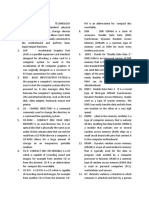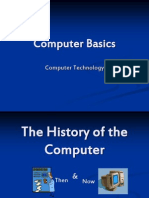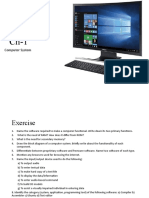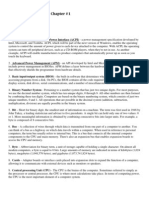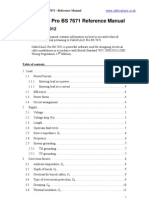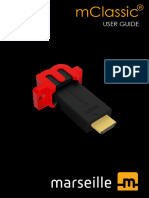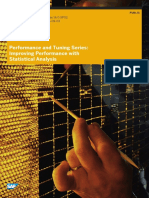DEFINITION OF COMPUTER TERMS
___________________________________________________________________________
COMPUTER HARDWARE SERVICING NC II Alinajeb D. Macarimbang 2012
Address – a number that represent a unique location in memory.
ALU – Arithmetic Logic Unit, part of a microprocessor. It does all arithmetic
functions and calculation in the CPU.
ASCII – American Standard Code for Information Interchange, code
representing the character symbols possible for specific hexadecimal codes.
BIOS – Basic Input/Output System, the part of the operating system that
controls the input and output functions.
Bit – the single smallest unit of data in a computer.
Board – a shortened reference to a printed circuit board or the insulated surface
on which circuit components are mounted and soldered in place.
Boot – a term meaning to load DOS or an operating system.
Byte – comprised of 8 bits to form a word
Character – the equivalent meaning of byte formed.
Chip – a complete electronic circuit which may contain miniature resisters,
transistors, diodes, and related circuitry all integrated into a miniature silicon base and
mounted in a common housing.
Computer – an electronic device designed to make rapid, accurate computations
from data programmed into it.
Control Unit – decodes each instruction that enters the computer. It then generates
the necessary pulses to carry out the functions specified.
CP/M – Control Program for Microprocessors, the first operating system developed for
microcomputers.
CPU – Central Processing Unit, the heart of a system. It controls all data
transfer and devices in a microcomputer system.
DMA – Direct Memory Access, data transfer involving large blocks of information directly
between the memory and disk drives. DMA is
controlled by another processors which speeds up data transfer and
unloads the central processors of this function.
DOS – Disk Operating System, a software program used to set certain
parameters involving the operation of the computer system. To start it
up especially data transfer and the disk drives.
Hardcopy – a print out or a visual copy on paper.
I/O – short for Input/Output, any operation or device that sends or receives
data from or to the CPU.
IC – short for Integrated Circuit, building blocks of a computer system or
other electronics devices comprising many electronics parts such as
transistors, resistors, etc. in a single package.
Interrupt – an input signal to the processors that sets the order to initialize all
System devices for operation.
1
� Kilo – prefix which means 1,000 units
LSI – Large Scale Integration, describes the intensity of integration
commonly used in microprocessors, comprising many ICs.
Mainframe computers – the largest and most expensive computers designed
specifically to serve business, industry, and government in
applications that require mass storage and fast retrieval.
Example: Banks, airlines, and the Internal Revenue Service use mainframe Computers
Mega – prefix which means 1,000,000 units
Memory – the part of a computer that stores vital information for the computer’s operation.
Microcomputers – the smallest and least expensive computers, designed for desktop or
portable use by an individual at home, yet versatile enough for applications in business,
industry, and government.
Example: Microcomputers enjoyed early popularity in the home for both educations and
playing electronic games, but as microcomputers expand in powers such as muliti
tasking and multi-user applications, their use in business and industry increases.
Microprocessor – the arithmetic logic unit, registers, and timing and decoding circuitry usually
contained in a single integrated circuit that controls computer activities.
Minicomputers – medium-sized and medium-priced computers that rival the
storage capacity and operating speed of smaller main-frames, and are used in
business, industry, and government where they perform mostly dedicated or
single-task activities.
Example: Food processors, laboratories, and hospitals use minicomputers
Peripheral – any device or accessory such as a disk drive, printer, modem, or video display
added to a microcomputer to provide increased capacity for handling, storing, or presenting
data.
POR – Power On Reset, or power on routing, term to describe the sequence of
operations of a machine during power up.
Programs – contain the instructions that tell the computer what to do. It is a sequential set of
instructions to solve a particular problem.
Prototype – the first of its kind, the original from which later models are patterned.
RAM – Random Access Memory, data can either be read from or written to(read/write).
Read – to get data from a device.
Reset – a short pulse during power up of perform control function in computer, used to
initialize all system devices for operation.
ROM – Read Only Memory, data can only be read from this type of memory. It cannot
be altered and contains the basic operating instruction of the computer.
Unix – the operating system used by the IBM PC, having a more powerful command
structure and greater expandability than CP/M
Write – to put data into a device.
2
� COMPUTER ACRONYMS
ACE - Asynchronous Communication Element ISA - Industry Standard Architecture
ACPI - Advance Configuration and Power Interface JFET - Junction Field Effect Transistor
ADC - Analog-to-Digital Converter JPEG - Joint Photographic Experts Group
ADO - Active Data Object LAN - Local Area Networking
ADSL - Asymmetric Digital Subscriber LED - Light Emitting Diode
Line (variant of DSL) LBA - Logical Block Addressing
AGP - Accelerated Graphics Port LSB - Least Significant Bit
ALU - Arithmetic Logic Unit MAN - Metropolitan Area Network
AMR - Audio Modem Riser MB - Megabyte
API - Application Programming Interface MHz - Megahertz
ASCII - American Standard Code for MIDI - Musical Instrument Digital Interface
Information Interchange MPEG - Motion Pictures Experts Group
ATA - Advanced Technology Attachment MODEM - Modulator Demodulator
BCD - Binary Coded Decimal MPU - Microprocessor Unit
BEDO RAM - Burst EDO RAM NTFS - New Technology File System
BIOS - Basic Input Output System OCR - Optical Character Recognition
BIU - Bus Interface Unit OS - Operating System
CGI - Common Gateway Interface PATA - Parallel ATA
CAD - Computer – Aided Design PC - Personal Computer
CMOS - Complementary Metal Oxide Semiconductor PCB - Printed Circuit Board
CPU - Central Processing Unit PCI - Peripheral Component Interconnect
CRT - Cathode Ray Tube PIC - Programmable Interval Controller
DMA - Direct Memory Access PPI - Programmable Peripheral Interface
DTE - Data Terminal Equipment PDF - Portable Document Format
DDR - Double Data Rate PNG - Portable Network Graphics
DIMM - Dual Inline Memory Module PnP - Plug-and-Play
DLL - Dynamic Link Library PS/2 - Personal System/2
DNS - Domain Name System RAID - Redundant Array of Independent Disks
DOS - Disk Operating System RAM - Random Access Memory
DRAM - Dynamic Random Access Memory RISK - Reduce Instruction Set Computing
DSL - Digital Subscriber Line RMW - Read/Modify/Write
DVD - Digital Versatile Disc R/W - Read/Write
EDO - Enhanced Data Output ROM - Read Only Memory
EPROM - Erasable Programmable Read Only Memory RGB - Red Greed Blue
FAT - File Allocation Table SATA - Serial ATA
FRAM - Ferro-Magnetic RAM SCSI - Small Computer System Interface
FDD - Floppy Disk Drive SDRAM - Synchronous Dynamic RAM
FSB - Front Side Bus SRAM - Static RAM
FTP - File Transfer Protocol SVGA - Super Video Graphics Array
GIF - Graphics Interchange Format SMART-Self-Monitoring, Analysis, and
GPRS - General Packet Radio Service Reporting Technology
GSM - Global System for Mobile SSRAM - Synchronous Static RAM
Communication TCP/IP - Transmission Control
GUI - Graphical User Interface Protocol/ Internet Protocol
HDD - Hard Disk Drive URL - Uniform Resource Locator
HTML - Hypertext Markup Language UPS - uninteraptable Power Supply
HTTP - Hypertext Transport Protocol USB - Universal Serial Bus
IC - Integrated Circuit VGA - Video Graphics Array/Adapter
IBM - International Business Machines VIRUS - Vital Information Resource Under Seize
ICT - Information and Communication Technology WAN - Wide Area Network
IDE - Integrated Drive Electronics WAP - Wireless Application Protocol
I/O - Input/Output Wi-Fi - Wireless Fidelity
IP - Internet Protocol WLAN9 - Wireless Local Area Network
IRQ - Interrupt Request www - World Wide Web
IT - Information Technology ZBR – Zone Bit Recording






